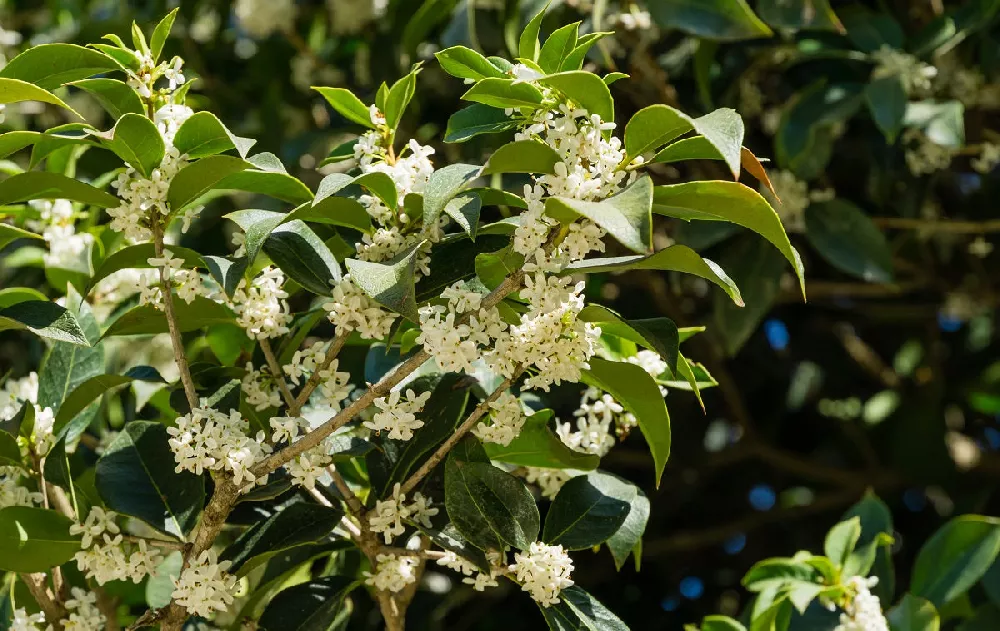- Home >
- Shrubs and Bushes >
- Fragrant Tea Olive Trees
Fragrant Tea Olive Trees for Sale - Buying & Growing Guide
- Ships in 1-2 days
- 1-Year Warranty Eligible
- Pots or accessories are not included unless specified in the product options.
Shipping Details:
Products shipped through FastGrowingTrees.com. Once your order is shipped, you’ll receive an email with a tracking number and estimated delivery date. Most orders will ship immediately.
The fragrant tea olive tree (Osmanthus fragrans), also called the sweet osmanthus or sweet olive, is known for its fragrant white flowers. It is drought tolerant and has a sweet aroma, hence its common name. Here are some other facts about fragrant tea olive trees:
- The plant’s wonderful fragrance is reminiscent of apricots and peaches.
- The species is native to Asia, including parts of Taiwan, China, and the Himalayas.
- The shrub’s attractive green foliage provides a backdrop for the sweet-smelling flowers that bloom throughout the year.
Plant Care
Sunlight

Give this plant at least six hours of sunlight for the best growth. Will survive in partial shade.
Watering
Established trees need water during drought periods. Young plants do best with weekly watering.
Fertilizing

Fertilize in spring with a formula that is equal parts nitrogen, phosphorus, and potassium.
Planting and Care
Planting instructions
Before planting, you’ll want to thoroughly soak the roots and let the plant sit in the shade for a couple of days. Then, choose a planting site with well-draining, slightly acidic soil that receives full sun. Avoid areas with extended periods of shade. Dig a hole the depth of the root ball and twice as wide. Place the plant in the hole, keeping it upright and level while you backfill with soil. Tamp down lightly and water the site thoroughly.
Watering and nutrients
Younger tea olive plants require more water than mature individuals. For the first few months, water once per week. After the first year, the plants will become more drought-tolerant and will need water during drought and in areas where rainfall is less frequent. You will need to add water when the soil is dry at a depth of three inches. In early spring, fertilize your tea olive plants with a slow-release all-purpose fertilizer for faster growth and more plentiful blooms.
Pollination
The fragrant tea olive tree relies primarily on bees for pollination. Due to the aromatic nectar produced in the flowers of the tea olive tree, many other insects will help pollinate the blooms as well. The tiny white blossoms on the tree will bloom in the spring and early summer months and then intermittently until early autumn. O. fragrans is considered to be a high nectar and pollen-producing plant, which increases its relative insect activity.
Pruning
Fragrant tea olive trees are plants that respond well to pruning, meaning that you can easily shape them as you please. Perform your pruning in the spring or in the early summer. Begin by sterilizing your pruning shears. Then, begin removing dead, diseased, and dying portions of the plant. Remove spent flowers to promote the growth of new ones.
Pests, diseases, and animals
Root rot can occur in tea olive trees when they are overwatered. Make sure your plants are in well-drained soil, and be sure not to water too often to avoid this fungal disease. Scale is a common pest on O. fragrans and is usually found on the underside of leaves (the tiny insects look like a white powdery substance). Start by removing infected foliage, but if the problem persists, you can also use horticultural oil to deter the pests.
FAQs
How big do fragrant tea olive trees grow?
Fragrant tea olive plants usually grow into the shape of a small tree or shrub. These formations can reach a height of 10 feet if left to grow. The plant takes on a rounded shape that expands to a width of six to eight feet. The plant will grow at a moderate rate, usually putting 12 to 18 inches of new growth per year. With regular prunings, the plants can be kept much smaller if the gardener so desires.
How are the fragrant flowers used?
With such a potent, sweet smell, the flowers of the fragrant tea olive plant have been used in a variety of ways. In China, the blooms have been used as an additive to black or green tea, adding an apricot-like flavor to the beverage. Osmanthus jams, jellies, and sauces are common and are used as a sweet flavoring for various dishes and desserts. In India, the flowers are even used as insect repellent, similar to the effects of Citronella.
Can fragrant tea olive plants be grown in containers?
Fragrant tea olive trees can be successfully grown in containers. This allows colder climates to enjoy the species, and it can also extend the productive season of the plant. Choose the largest available pot to plant your tea olive shrubs, making sure that the roots will have enough space to spread and develop. Whenever the soil dries to a depth of two or more inches, you will want to perform a thorough watering. The plants can be moved indoors or into a greenhouse when the temperatures become too cold.
What plants grow well with Ostmanthus fragrans?
Many different species make great companion plants for fragrant tea olive trees. The species makes a wonderful addition to pollinator gardens, performing well with the likes of dogwood shrubs, coneflowers, and various Salvia species. Fragrant tea olives can grow into a rather large formation, so planting smaller species in front will provide more visual appeal and prevent any sun blockage. Osmanthus fragrans blooms primarily in the fall, so try planting spring and summer bloomers to balance out the beauty.








